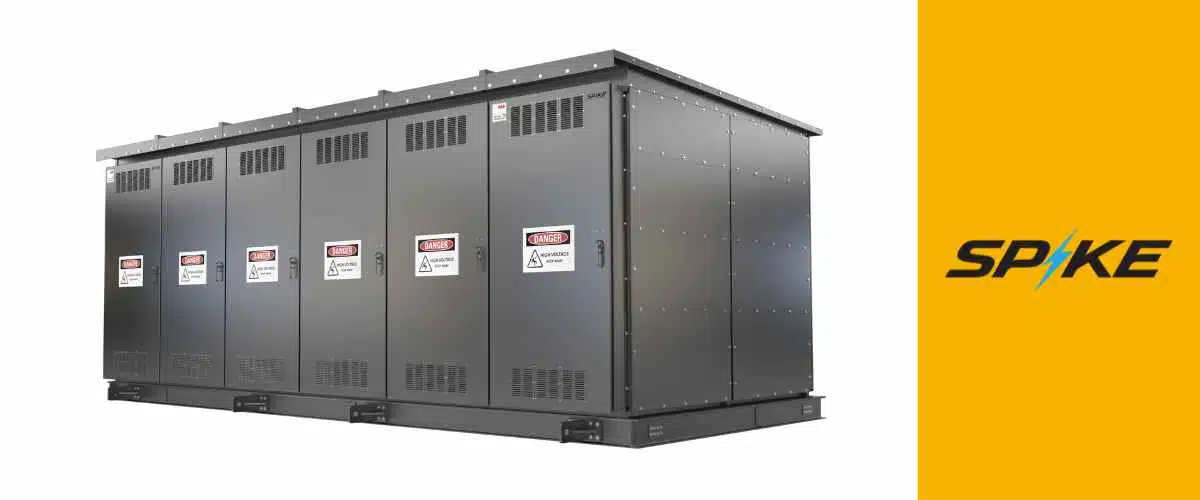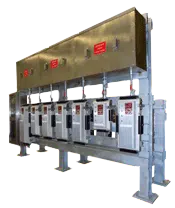A circuit breaker disconnect is a broad term that can be a single breaker or multiple breakers in a system used to disconnect or turn on and off the flow of electricity to devices. In a typical application a circuit breaker disconnect will be a single circuit breaker in an enclosure that can be safely disconnect by either opening the door and toggling the switch on and off or with an external handle that will throw the breaker handle inside the enclosure safely without opening the door.
Circuit breaker disconnects are essential safety devices that protect electrical circuits from overload and short circuits. They are typically located in the main electrical panel of a building, and they can be used to isolate individual circuits or groups of circuits for maintenance or repair.
Circuit breaker disconnects work by tripping a switch that opens the circuit, interrupting the flow of electricity. This can be done manually or automatically, depending on the type of circuit breaker.
A circuit breaker is an automatically operated electrical switch designed to protect an electrical circuit from damage caused by excess current from an overload or short circuit. Its basic function is to interrupt current flow after a fault is detected. Unlike a fuse, which operates once and then must be replaced, a circuit breaker can be reset (either manually or automatically) to resume normal operation.
Types of Circuit Breaker Disconnects
1. Main Breaker Panel (Main Service Panel):
This is the most common type of service disconnect. It’s a single panel with a main circuit breaker and individual circuit breakers for each of the building’s circuits. The main breaker controls the power to all of the circuits in the panel and serves as the primary disconnect for the service entrance.
2. Meter Main (Meter Combination Main):
Meter mains are service entrance equipment that combines the meter mounting device with a main breaker or main fuse pullout, serving as the main disconnect. It’s a more compact setup, saving space and sometimes allowing for faster shutdown during emergencies.
3. Main Lug Only Panel (MLO):
This type of panel doesn’t include a main breaker. Instead, it has main lugs where the service wires are connected. It’s often used in situations where there is a separate disconnect upstream, closer to the meter or at the meter itself. An external disconnect switch must be used with MLO panels.
4. Main Breaker Meter Main with Distribution Section:
This is a more comprehensive unit that includes a meter socket, main breaker, and a section for distribution, all in one. It’s efficient for managing multiple circuits and is commonly used in residential complexes or commercial buildings.
5. Transfer Switch with Service Disconnect:
Used in systems with backup generators, this setup includes a transfer switch combined with a service disconnect, allowing the building to safely switch between utility power and generator power. The service disconnect aspect handles the overcurrent protection and the ability to disconnect the building from the utility feed.
6. Disconnect Switch (Safety Switch):
While not a panel with multiple circuit breakers, this is a standalone switch located between the meter and the panel, serving as the main disconnect at the service entrance. It’s used where the panel is located some distance from the entrance point or in commercial settings for added safety.
7. Circuit Breaker Enclosure with Service Disconnect:
This is essentially a simplified version of the main breaker panel, containing just a single main circuit breaker housed in its own protective enclosure, and it acts as the service disconnect.
8. Mobile Home Panel:
Specifically designed for mobile homes, these are often all-in-one units incorporating a main breaker, individual circuit breakers, and sometimes the meter base itself. They are designed to handle the unique requirements of mobile home electrical systems.
When to Use Circuit Breaker Disconnects
1. When performing maintenance or repair on a circuit:
Maintenance and repairs often require a circuit to be de-energized to prevent electrical shocks or other dangers. Using a circuit breaker disconnect ensures that no electricity is flowing through the system, creating a safe environment for maintenance personnel. It also helps in protecting equipment from power surges or interruptions that could cause damage during the maintenance process.
2. When installing new equipment on a circuit:
Installing new electrical equipment or machinery can be risky if the circuit is live. There may be unexpected power loads, short circuits, or physical dangers associated with electrical installations. By using a circuit breaker disconnect, workers can ensure they are not exposed to live circuits during the installation process. It also protects the equipment being installed from potential electrical faults that could cause damage upon initial power up.
3. When troubleshooting a circuit problem:
Electrical troubleshooting often requires close contact with electrical circuits to determine the source of a problem. This could involve testing for electrical continuity, inspecting wiring, or identifying issues with circuit components. Using a circuit breaker disconnect during this process eliminates the risk of electrocution and allows for a more thorough investigation, as it might require disconnecting certain parts of the circuit to accurately identify the issue.
4. When disconnecting a circuit from the power source:
There are scenarios where a circuit needs to be completely disconnected from the power source, such as during major electrical modifications, decommissioning of facilities, or in response to a persistent electrical hazard. In these cases, a circuit breaker disconnect is used to ensure a complete and total separation of the circuit from the electrical supply, thereby preventing any accidental energizing of the circuit and ensuring the safety of individuals and infrastructure involved.
Benefits of Using Circuit Breaker Disconnects
There are several benefits to using circuit breaker disconnects, including:
- Safety: Circuit breaker disconnects help to prevent electrical fires and other hazards by isolating circuits when they are not in use.
- Convenience: Circuit breaker disconnects can be used to easily and safely disconnect individual circuits or groups of circuits for maintenance or repair.
- Flexibility: Circuit breaker disconnects are available in a variety of sizes and configurations to meet the needs of any application.
Enclosed Circuit Breaker Disconnect Selection Checklist:
1. Electrical Specifications:
- Amperage Rating: Confirm the disconnect can handle the maximum current load of your circuit.
- Voltage Rating: Check that the disconnect’s voltage rating meets or exceeds your system’s requirements.
Interrupting Rating: Ensure the disconnect can handle the highest possible fault current that can occur.
2. System Compatibility:
- Number of Poles: Choose single-pole, double-pole, etc., based on your circuit configuration.
- System Type: Match the disconnect to your system (single-phase, three-phase, etc.).
- Wire Size: Confirm the disconnect can accommodate the wire size used, especially for high-current applications.
3. Type and Function:
- Switching Frequency: Consider the expected frequency of operation, ensuring the disconnect can withstand wear and tear.
- Special Functions: Evaluate if you need additional features like ground fault or surge protection.
4. Compliance and Standards:
- Regulatory Compliance: Check local codes and industry standards to ensure the disconnect meets regulatory requirements.
- Certifications: Look for relevant certifications (UL, CE, etc.) indicating quality and safety standards. UL & NEC are standard certifications.
5. Environmental Conditions:
- Enclosure Type: Select the right enclosure rating (NEMA or IP) based on environmental exposure (dust, water, chemicals, etc.).
- Operating Temperature: Ensure the disconnect can operate safely within the ambient temperature range of its location. This is usually standard per UL or NEC.
- Hazardous Locations: If applicable, choose a disconnect designed for hazardous areas (explosive, flammable, etc.).
6. Installation and Access:
- Mounting Options: Consider the available space and mounting possibilities (wall, pole, etc.).
- Access and Operation: Ensure the disconnect is easily accessible for regular operation, emergency shut-offs, or maintenance.
- Space Requirements: Check the physical dimensions to confirm it fits the allocated space, with room for safe operation.
7. Safety and Convenience:
- Lockout/Tagout Capability: Choose a disconnect that supports lockout/tagout procedures for enhanced safety. This is an NEC requirement for all circuit breaker disconnects.
- Visibility: Consider disconnects with clear ON/OFF indicators or windowed enclosures for status checks.
8. Manufacturer Credibility and Support:
- Verify the manufacturer uses new, warrantied breakers and maintains a strong relationship with component suppliers.
- Check that the manufacturer is ISO 9001 certified, reflecting their commitment to quality.
- Confirm that the manufacturer holds relevant UL listings, ensuring their products meet specific safety standards.
- Investigate the manufacturer’s history, looking for a minimum of 10 years in the enclosed circuit breaker business and a positive industry reputation.
- Ensure the manufacturer has qualified engineers on staff for technical support and troubleshooting.
- Confirm that the manufacturer understands service breaker disconnect requirements and adheres to proper labeling standards.
9. Future Proofing and Reliability:
- Consider the potential for future upgrades or increased load requirements.
- Opt for a brand known for reliability and quality.
- Investigate the terms of the warranty and availability of customer support.
Installation and Maintenance of Circuit Breaker Disconnects
Circuit breaker disconnects should be installed by a qualified electrician. They should also be inspected and maintained regularly to ensure that they are in good working condition.
Conclusion
Circuit breaker disconnects are essential safety devices that protect electrical circuits from overload and short circuits. They are available in a variety of sizes and configurations to meet the needs of any application. When choosing a circuit breaker disconnect, it is important to consider the amperage rating, voltage rating, number of poles, and type of circuit breaker. Circuit breaker disconnects should be installed and maintained by a qualified electrician.
Written by: Cole Attaway
Cole Attaway is the founder and CEO of Spike Electric Controls. Spike’s mission is to improve the accessibility and delivery of industrial electrical gear for clients nationwide. Spike solutions result in reduced unplanned downtime, less overtime, and greater operational efficiencies.
The highest quality at the quickest speed.
Spike can deliver the same name-brand electrical gear in a fraction of the time.
Explore Our PowerClad Medium Voltage Switchgear Options




